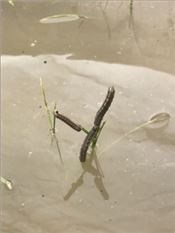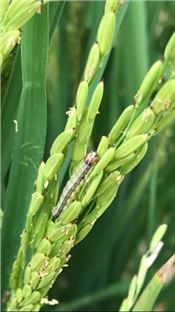|
Refined Treatment Threshold In The Works For Fall Armyworm In Arkansas Rice
LONOKE, ARK.
Fall armyworms, a common pest of soybeans, pastures and lawns, have developed a taste for rice and extension entomologists are working on management methods to help producers.
Gus Lorenz and Nick Bateman, extension entomologists for the University of Arkansas System Division of Agriculture say answers to grower questions aren’t as simple as they’d like.
“We’re starting to get a lot of phone calls about fall armyworms in the state, particularly in rice,” Bateman said, adding, “and our current threshold is adopted from wheat, which isn’t so accurate in rice.”
The ‘uh-oh’ threshold
Although a precise threshold does not currently exist, Lorenz has a basic recommendation for growers.
“This may not be the exact threshold,” he said, “but if you walk up on a field and you see these fall armyworms and your first thought is ‘uh-oh,’ you probably need to treat.”
Lorenz added that checking around the edges of fields and watching for certain weeds can give a grower the hints they need.
“A really quick way to see if you have a problem is to go around the edges of your field, particularly fields surrounded by woods on two or three sides, these are hot spots,” Lorenz said. “If you go to a turn row and you have broadleaf signal grass covered in fall armyworm, you need to scout that field.”
Examining defoliation
UA-Fayetteville graduate student Layton McCullars is working to give growers a specific threshold that will be based on how much damage the caterpillars have caused.
“Our threshold is going to be based on percent defoliation,” McCullars said. “So growers can say ‘this much of the plant is gone, so I should spray.’”
McCullars is observing different levels of defoliation and the resulting yield loss.
“We’re manually defoliating our plots with scissors and with weed eaters,” McCullars said, “We’re cutting plots down to 25, 50 and 100 percent defoliation to see at what stage we start to see yield impacts.”
Last summer’s data showed the rice can take quite a hit before yield is lost.
“Prior to heading, growers need to start worrying when they get up to about 40-50 percent defoliation,” Bateman. “Based on some preliminary work we did last year, we didn’t see major yield impacts until we started getting some really high defoliation levels.”
Although pre-headed rice can handle up to 40-50 percent defoliation, headed rice is not as able to bounce back.
“Once we get to heading, if you get feeding on the flag leaf or the flag leaf minus one (meaning the predominant leaf or the leaf below it) and you have about 25 percent defoliation, then that would be a good indicator to treat,” Lorenz said. “Pre-heading rice can take more defoliation at that time, it just might delay maturity a little bit.”
Whether it’s in pre-heading or headed rice, both Bateman and Lorenz warn against trigger-happy applications.
“The products we’re going to use to control fall armyworms are mainly pyretheroids, which can be very damaging to our beneficial insects,” Bateman said. “Prior to heading we usually have a large number of long-horned grasshoppers and those grasshoppers feed on rice stinkbug eggs. So, if we have a low amount of defoliation and we make an application to control the fall armyworm anyway, we kill our beneficial insects that would control that rice stinkbug population. We could end up hurting ourselves down the road and costing ourselves money.”
Lorenz said he’s seen the damage unnecessary applications can cause first hand.
“We’ve seen this a few times where growers sprayed for fall armyworm and killed all the beneficial insects that feed on rice stinkbug eggs and those people had a fit trying to control rice stinkbug in those fields,” Lorenz said. “We don’t want to upset that delicate balance and ecosystem by destroying our beneficial insects if we don’t have to.”
The most important thing growers can do right now is to scout.
“Being that it’s just the beginning of July, we expect the populations are going to build over time,” Lorenz said. “Right now we’re alerting growers that they need to be scouting their late planted rice and looking for developing populations of fall armyworms, particularly in the edges of fields.” ∆
 (Top photo) Fall Armyworms trying to avoid flood in rice. Taken at the Pine Tree Station, 2017.
(Top photo) Fall Armyworms trying to avoid flood in rice. Taken at the Pine Tree Station, 2017.
(Bottom photo) Fall armyworms in rice. Taken at the Rice Research and Extension Center, Stuttgart, Arkansas, 2017.
Images courtesy Layton McCullers

|
|